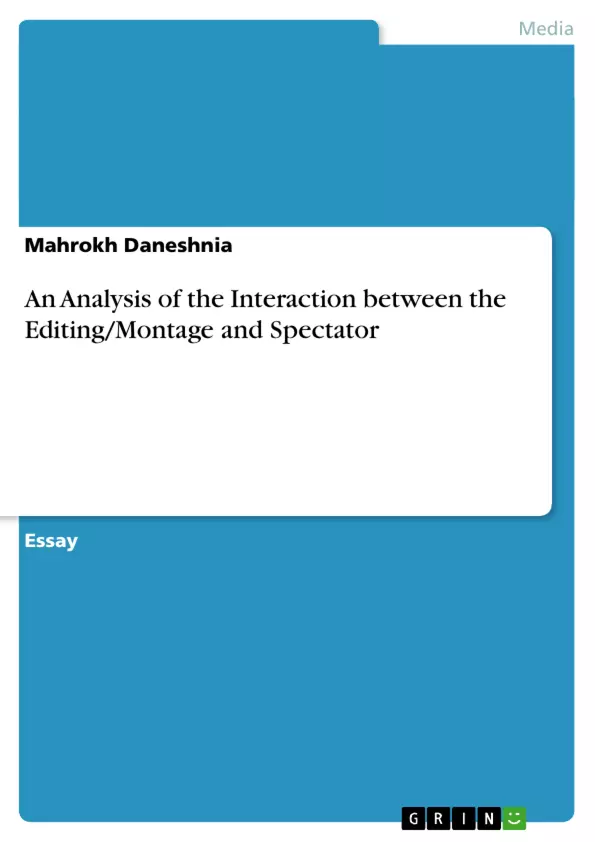This essay analyses early theories in regards to editing and montage as a film form and its relationship to the meaning that it creates in spectator’s mind. The main statement to prove in this essay is that controlling editing methods ignores the spectator’s imagination and conflictive editing is the right method to interact with spectator’s mind creatively. The essay considers Hugo Munsterberg, Sergei Eisenstein and Vsevolod Pudovkin’s essays by clarifying the major points and debating the similarities and dissimilarities between the three arguments.
Inhaltsverzeichnis (Table of Contents)
- An Analysis of the Interaction between the Editing/Montage and Spectator
Zielsetzung und Themenschwerpunkte (Objectives and Key Themes)
This essay analyzes early film theories regarding editing and montage and their relationship to the spectator's experience. It argues that controlling editing methods stifle the spectator's imagination, while conflictive editing fosters creative engagement. The essay compares and contrasts the theories of Hugo Munsterberg, Sergei Eisenstein, and Vsevolod Pudovkin.
- The psychological impact of editing techniques on the spectator.
- The role of montage in shaping meaning and controlling spectator attention.
- A comparison of Munsterberg, Eisenstein, and Pudovkin's theories on editing and montage.
- The importance of conflictive editing in stimulating the spectator's imagination.
- The contrast between controlling and creative approaches to film editing.
Zusammenfassung der Kapitel (Chapter Summaries)
An Analysis of the Interaction between the Editing/Montage and Spectator: This essay explores early film theories concerning editing and montage, focusing on their impact on the spectator's comprehension and engagement. It examines the perspectives of Hugo Munsterberg, Vsevolod Pudovkin, and Sergei Eisenstein, highlighting their differing views on the purpose and function of editing techniques. Munsterberg, focusing on psychological processes, views editing as a reflection of the mind's work of memory and imagination, utilizing techniques like parallel editing and flashbacks to mirror these cognitive processes. Pudovkin, a Soviet filmmaker, emphasizes the director's control over the spectator's attention through editing, proposing methods like contrast, parallelism, and symbolism to elicit specific emotional responses. Eisenstein, however, challenges both Munsterberg and Pudovkin, arguing that montage, as a collision of contrasting shots, sparks intellectual engagement and allows the spectator to actively create meaning, rather than passively receiving it. The essay ultimately advocates for Eisenstein's approach, emphasizing the importance of conflictive editing in fostering creative interaction with the film.
Schlüsselwörter (Keywords)
Film editing, montage, spectator engagement, Hugo Munsterberg, Vsevolod Pudovkin, Sergei Eisenstein, psychological film theory, Soviet montage, conflictive editing, parallel editing, close-up.
Frequently Asked Questions: An Analysis of the Interaction between Editing/Montage and Spectator
What is the main topic of this essay?
This essay analyzes early film theories regarding editing and montage and their relationship to the spectator's experience. It focuses on the impact of different editing techniques on the spectator's comprehension and engagement, comparing and contrasting the theories of Hugo Munsterberg, Sergei Eisenstein, and Vsevolod Pudovkin.
What are the key themes explored in the essay?
The key themes include the psychological impact of editing techniques on the spectator, the role of montage in shaping meaning and controlling spectator attention, a comparison of Munsterberg, Eisenstein, and Pudovkin's theories, the importance of conflictive editing in stimulating the spectator's imagination, and the contrast between controlling and creative approaches to film editing.
Whose theories are compared and contrasted in the essay?
The essay compares and contrasts the theories of Hugo Munsterberg, Sergei Eisenstein, and Vsevolod Pudovkin on film editing and montage.
What is Munsterberg's perspective on editing?
Munsterberg views editing as a reflection of the mind's work of memory and imagination, using techniques like parallel editing and flashbacks to mirror cognitive processes.
What is Pudovkin's perspective on editing?
Pudovkin emphasizes the director's control over the spectator's attention through editing, using methods like contrast, parallelism, and symbolism to elicit specific emotional responses.
What is Eisenstein's perspective on montage?
Eisenstein argues that montage, as a collision of contrasting shots, sparks intellectual engagement and allows the spectator to actively create meaning, rather than passively receiving it. He advocates for "conflictive editing" to foster this creative interaction.
What is the essay's conclusion regarding editing techniques?
The essay ultimately advocates for Eisenstein's approach, emphasizing the importance of conflictive editing in fostering creative interaction with the film. It argues that controlling editing methods stifle the spectator's imagination, while conflictive editing fosters creative engagement.
What are the key terms used in the essay?
Key terms include film editing, montage, spectator engagement, Hugo Munsterberg, Vsevolod Pudovkin, Sergei Eisenstein, psychological film theory, Soviet montage, conflictive editing, parallel editing, and close-up.
What is the purpose of the chapter summary?
The chapter summary provides a detailed overview of the essay's main argument, outlining the perspectives of Munsterberg, Pudovkin, and Eisenstein on editing and montage, and highlighting the essay's conclusion favoring Eisenstein's concept of conflictive editing.
- Arbeit zitieren
- Mahrokh Daneshnia (Autor:in), 2013, An Analysis of the Interaction between the Editing/Montage and Spectator, München, GRIN Verlag, https://www.grin.com/document/271504



